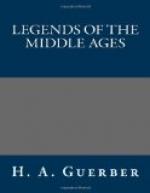In this battle Brutus’ nephew, Turonus, fell, and was buried on the spot where the city of Tours was subsequently built and named after the dead hero. After having subdued his foes, Brutus embarked again and landed on an island called Albion. Here he forced the giants to make way for him, and in the encounters with them Corineus again covered himself with glory.
We are told that the first germ of the nursery tale of Jack the Giant Killer is found in this poem, for Corineus, having chosen Corinea (Cornwall) as his own province, defeated there the giant Goemagot, who was twelve cubits high and pulled up an oak as if it were but a weed. Corineus, after a famous wrestling bout, flung this Goemagot into the sea, at a place long known as Lam Goemagot, but now called Plymouth.
[Sidenote: The founding of London.] Brutus pursued his way, and finally came to the Thames, on whose banks he founded New Troy, a city whose name was changed in honor of Lud, one of his descendants, to London. Brutus called the newly won kingdom Britain, and his eldest sons, Locrine and Camber, gave their names to the provinces of Locria and Cambria when they became joint rulers of their father’s kingdom, while Albanact, his third son, took possession of the northern part, which he called Albania (Scotland).
Albanact was not allowed to reign in peace, however, but was soon called upon to war against Humber, King of the Huns. The latter was defeated, and drowned in the stream which still bears his name. Locrine’s daughter, Sabrina, also met with a watery death, and gave her name to the Severn.
[Sidenote: King Leir.] The posterity of Brutus now underwent many other vicissitudes. There was fighting at home and abroad; and after attributing the founding of all the principal cities to some ruler of this line, the historian relates the story of King Leir, the founder of Leicester. As this monarch’s life has been used by Shakespeare for one of his dramas,—the tragedy of “King Lear,”—and is familiar to all students of English literature, there is no need to outline Geoffrey of Monmouth’s version of the tale.
The chronicler then resumes the account of Brutus’ illustrious descendants, enumerating them all, and relating their adventures, till we come to the reign of Cassivellaunus and the invasion of Britain by the Romans. Shortly after, under the reign of Cymbelinus, he mentions the birth of Christ, and then resumes the thread of his fabulous history, and brings it down to the reign of Uther Pendragon, where it has been taken up in the Arthurian cycle.
This chronicle, which gave rise to many romances, was still considered reliable even in Shakespeare’s time, and many poets have drawn freely from it. The mediaeval poets long used it as a mental quarry, and it has been further utilized by some more recent poets, among whom we must count Drayton, who makes frequent mention of these ancient names in his poem “Polyolbion,” and Spenser, who immortalizes many of the old legends in his “Faerie Queene.”




